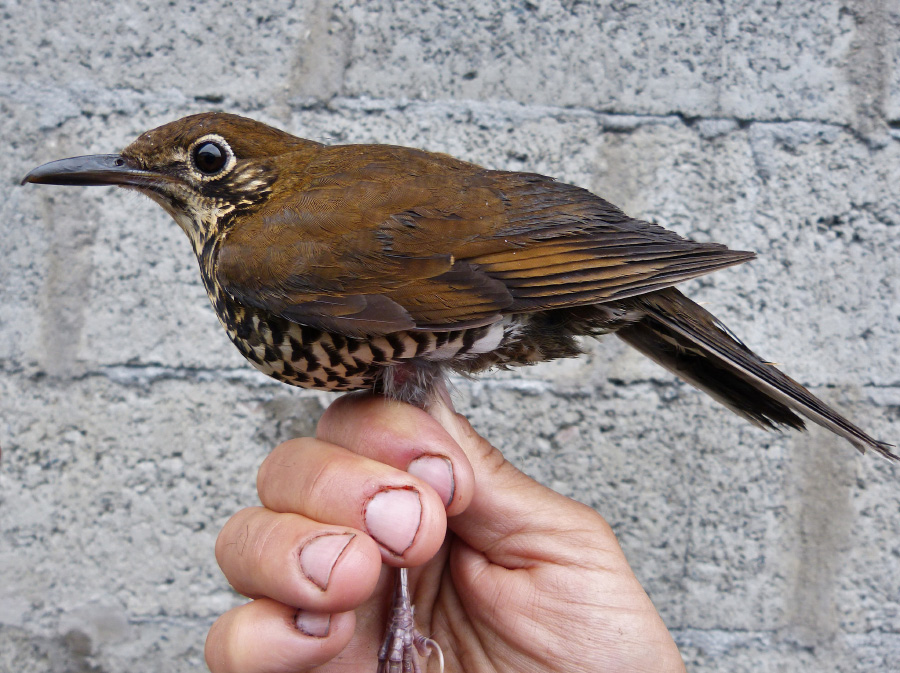A new species of bird has been described from northeastern India and adjacent parts of China by a team of scientists from Sweden, India, China, the US, and Russia.
The bird has been named Himalayan Forest Thrush (Zoothera salimalii). The scientific name honours the great Indian ornithologist Dr Sálim Ali (1896–1987), in recognition of his huge contributions to the development of Indian ornithology and wildlife conservation. This is the first Indian bird named after Dr. Salim Ali.
Dr. Per Alström and Shashank Dalvi first discovered the Himalayan Forest Thrush in May-June of 2009 while studying birds at high elevations of Western Arunachal Pradesh. It was realised that what was considered a single species, the Plain-backed Thrush (Zoothera mollissima), was in fact two different species in northeastern India.
What first caught the attention of the scientists was the fact that the “Plain-backed Thrush” in the coniferous and mixed forest had a rather musical song, whereas individuals found in the same region, but on bare rocky habitats above the tree-line had a much harsher, scratchier, unmusical song.
Studies of museum specimens in 15 museums in 7 countries revealed consistent differences in plumage and structure between birds from these two populations. It was confirmed that the species breeding in the forests of the eastern Himalayas had no scientific name.
They have therefore named this new species Himalayan Forest Thrush (Zoothera salimalii). The high-elevation “Plain-backed Thrush” is now renamed as Alpine Thrush while it retains the scientific name of Zoothera mollissima.
Further analyses of plumage, structure, song, DNA and ecology from throughout the range of the “Plain-backed Thrush” revealed that a third species was present in central China. While this population was already known, it was treated as a subspecies of “Plain-backed Thrush”. The scientists have instead called it Sichuan Forest Thrush. The song of the Sichuan Forest Thrush was found to be even more musical than the song of the Himalayan Forest Thrush.
DNA analyses suggested that these three species have been genetically separated for several million years. Genetic data from three old museum specimens indicated the presence of a fourth species from China that remains unnamed. Future field studies are required to confirm this.
The Himalayan Forest Thrush is locally common. It has been overlooked until now because of its close similarity in appearance to the Alpine Thrush.
New bird species are rarely discovered nowadays. Since 2000, an average of five new species per year have been discovered globally, most of which are from South America. The Himalayan Forest Thrush is only the fourth new bird species described from India since our independence in 1947.
More information:
Shashank Dalvi
Alumnus of the Post Graduate Program, Wildlife Biology and Conservation WCS-India Program NCBS, Bangalore
Email: shashank.da@gmail.com
Tel: +91 9869021909, +91 8454878230
Prof. Per Alström
Department of Animal Ecology, Evolutionary Biology Centre, Uppsala University, Sweden
and
Swedish Species Information Centre, Swedish University of Agricultural Sciences, Uppsala, Sweden
Email: per.alstrom@ebc.uu.se
Tel: +46 70 454 69 65
http://www.slu.se/per-alstrom-research
http://www.researchgate.net/profile/Per_Alstroem
The paper
Per Alström, Pamela C. Rasmussen, Chao Zhao, Jingzi Xu, Shashank Dalvi, Tianlong Cai, Yuyan Guan, Ruiying Zhang, Mikhail V. Kalyakin, Fumin Lei and Urban Olsson
Integrative taxonomy of the Plain-backed Thrush (Zoothera mollissima) complex (Aves, Turdidae) reveals cryptic species, including a new species. Avian Research. http://dx.doi.org/10.1186/s40657-016-0037-2 (Open Access)


 CI is a non-profit, non-commercial portal that aims to facilitate wildlife and nature conservation by providing reliable information and the tools needed to campaign effectively.
CI is a non-profit, non-commercial portal that aims to facilitate wildlife and nature conservation by providing reliable information and the tools needed to campaign effectively.